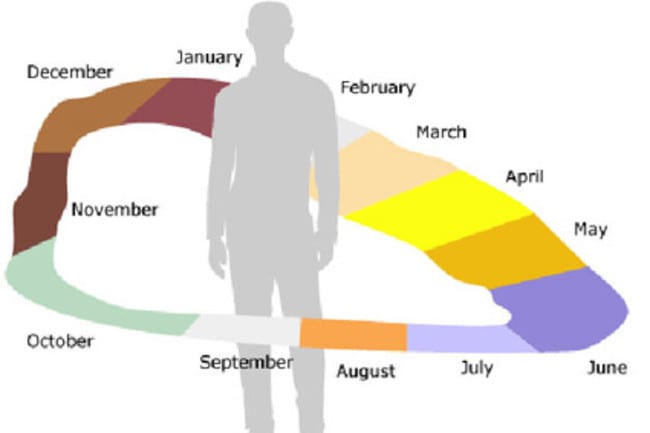See Also: 10 Animals With Incredible Eyes
10 Creative Individuals See The World Differently
Creativity is defined as the ability to see possibilities. A more technical term is “openness to experience.” This openness is what allows creative people to mine more information and ideas from an object, or idea, than the average individual. In 2017, scientists wanted to know if something else drove creativity. Clearly this trait was both emotional and mental, and could even be taught. But to find out whether creativity had roots in something physical, they snared a bunch of volunteers and made them look at colors. More specifically, the participants had to look at a green patch to the left and a red patch to the right—at the same time. Interestingly, those who were not really creative would switch their attention between the colors or experience a brief visual blend. People with more openness saw the blend more often and for a longer period of time. This strongly indicated that creative individuals literally see the world differently, in a physical sense that is separate from their emotional and mental artistic juices. Another test also confirmed that they see more details that other people screen out even when they are looking right at something.
9 The Blind Have More Nightmares
Can the blind see in their dreams? Yes, but only when they lost their sight was later in life. Interestingly, people who are born blind also have nightmares but experience them as emotions, sounds, and sensations, rather than anything visual. A recent study roped in volunteers in three groups to learn more about dreams. The first was born blind, the second turned blind and the final group had normal vision. Anxiety can trigger nightmares, but none of the participants had more jitters than the rest. Despite this, there was a major difference. The majority of nightmares showed up when the sight-impaired went to sleep. The blind-from-birth group had the most (around 25 percent of their dreams), while those who became blind underwent a curious decline. The longer they were blind, the fewer visuals appeared in their nightmares. However, the rate at which they had unpleasant dreams remained more frequent than the volunteers who could see. The study supported the theory that nightmares are linked to waking experiences. After all, when a person must navigate society in total darkness, they live with a higher awareness of threats and feelings of vulnerability.
8 Babies Notice Everything
Infants see reality in its entirety while adults no longer do. Grownups literally lose the ability to notice all the details in their visual field, but there is a good reason for that. Seeing every line, crack and hair will result in sensory overload. Babies need to see everything because their world is new and their brains are still figuring out what is important and what to ignore. In 2016, Japanese scientists showed babies photos of snails. A previous study had confirmed that infants stare for longer at new things and the snail-wielding scientists relied on that fact to determine whether children can see differences no longer obvious to adults. The photographs looked similar to the adult volunteers but the researchers knew which ones held subtle differences—and the rugrats found them. This was most obvious with those aged between three and four months old. However, the freaky supervision seems to disappear between the ages of five and eight months. By then, the newborn brain has realized that some things can be shelved and other details, like Mom’s face, are more important.
7 Children Who See Like Dolphins
The Moken is a nomadic sea-people and lives along the coastlines of Thailand, and the Andaman Sea. Adults hunt with spears but the kids dive for food and it was the youngsters’ ability to effortlessly find sea cucumbers and clams that provoked curiosity. More specifically, scientists noticed that Moken children navigated underwater without squinting their eyes. The researchers roped in European children on holiday and Moken volunteers. Several tests later and it became obvious that the local kids could see with clarity under the sea while everything appeared blurry to the Europeans. Remarkably, the Moken divers taught the holidaymakers how to do it but when asked, the visiting kids could not explain the actual process. They just “saw better.” This called for physical analysis. In a mysterious twist, the sea-nomads could change the shape of their eye lens and make the pupil smaller. This eliminated the fuzziness other people normally encounter underwater. This ability has only been found in dolphins and seals. How they do it, or why they lose this incredible ability in adulthood, remains unknown.
6 The Woman Who Sees 100 Million Colors
The human eye is adept at telling shades apart, allowing the average person to distinguish between 1 million colors. Even color-blind individuals notice around 100,000 different tints. The extreme end of the scale was found in 2007 when neuroscientists encountered a woman capable of seeing 100 million colors. The unnamed doctor from the United Kingdom was a “tetrachromat.” She was born with an extra cone cell in her eye, which prompted the super-vision. People with this additional fourth cone are so scarce that it took researchers 25 years to track down and confirm she was a genuine tetrachromat. Their existence has been suspected since the 1980s and her color tally was mathematically calculated. A few more women were later identified, but nobody knows how many tetrachromats are out there or why it seems to be an all-female trait. Why do these women, an estimated 12 percent of the population, not come forward? Scientists suspect that most true tetrachromats never use their extra cone and thus do not realize how special they are. One explanation is that the world’s color use is geared towards “normal” vision, which might deactivate this ability.
5 Motion-Induced Blindness
The human eye is like a camera with a slow shutter. As a result, moving objects sometimes trail streaks across our vision. The brain’s attempt to protect us from annoying streamers led to something called motion-induced blindness. For the most part, this phenomenon erases the lines. But it also causes stationary objects behind the moving ones to vanish. One minute the fire hydrant is there but as a car passes at night (here the brain wipes the tail light streamers), the hydrant is gone. This striking illusion is not a sign that our vision suffers from a serious glitch. As a species, humans evolved to notice moving things. Predators and prey had to be seen in order to survive and neither stood still. For this reason, scientists believe that motion-induced blindness helps to see whatever is moving with clarity, rubbing out the streaks that interfere with perception while also blotting out the things that do not move—nor matter—at that moment.
4 The Surprise Discovery Of BARM
When researchers in Germany tested a group of volunteers, they pretty much expected the results to confirm an old suspicion. The study aimed to conclusively prove the link between blinking and tOKN. The latter is an automatic reflex and a well-known feature of the eye. Supposedly, it resets the eye muscles when a person gazes at a rotating object. This prevents the muscles from twisting past their limits. The 2016 study stumbled upon something unexpected—a completely unknown eye movement was resetting the muscles. Since it happened automatically with each blink, the feature was called blink-associated resetting movement (BARM). The link with tOKN was confirmed but that was also how BARM turned up. As the volunteers gazed at rotating stuff, tOKN frequently occurred but the movement lacked efficiency. The muscles eventually twisted to the maximum limit of between three and eight degrees of rotation. At that point, BARM suddenly kicked in and completely untwisted the eye’s muscles.
3 There Are People Who See Calendars
We all see calendars. One just needs to look at the wall and there it is. A roughly square-shaped paper filled with blocks and dates. But a small percentage of the population—around 1 percent—can see an almanac in their mind’s eye. Where the rest of humanity must look at an outside source these individuals see a vivid grid without assistance. In fact, they can see the dates and days far into the future. This ability is called “calendar synaesthesia.” To listen to people describe how they experience this ability is spell-binding. One woman saw the months stretch before her in a V-shaped formation. Another’s calendar appeared as a large ring and no matter the time of year, December was always passing through her body. Both women cemented scientific conviction that the phenomenon was not just seeing an imaginary image. In 2016, both went against the scientists’ best attempts to ruin anything that could be a mental image. If they really were seeing the calendars, their ability would survive. Not only did the pair come through with flying colors but their tests provided the first direct evidence that calendar synaesthesia is not rooted in the mind, but in the brain. Just like other synaesthetes, who can taste words or hear colors, their brains stimulated several sensory and neurological pathways to produce a tangible outcome—in this case seeing a real calendar.
2 We See Infrared Light
Open any science textbook and it will tell you that humans cannot see certain wavelengths. These include radio waves, X-rays, ultraviolet and infrared light. As it turns out, the books are outdated. In 2014, it became clear that people can detect infrared light. Scientists were alerted to the fact after several of their colleagues reported seeing green flashes while working with infrared lasers. These look nothing like the lasers in action movies or pointers in boardrooms. Infrared lasers are supposed to be invisible. In order to unravel the surprising possibility of seeing things in the invisible spectrum, an international team descended upon the eye cells of mice and humans. During the tests that followed, they zapped different parts with pulses of infrared light. The results showed something incredible. The human retina detects this wavelength when hit with a particularly strong dose of infrared energy. The concentrated light particles lengthen the retina’s visual spectrum and this allows the human eye to temporarily see into the invisible range.
1 The Eye Sees Patterns The Brain Cannot Detect
At first blush, one would think that the eyeball can never be better than the brain. After all, eyes exist only to see while gray matter has many abilities. However, our blinkers beat the brain in one way and it surprised even the experts. Enter ghost images. These pictures are encoded as random patterns in other images. Only computers had the ability to pick up on their presence—or so everyone thought. In 2018, the complicated calculations required to identify the ghost images turned up in the human eye. Where the brain fails to see these individual patterns, the eye detects them, gathers the information and sums everything up. This might not sound so incredible until you realize the complicated nature of ghost images. Making one is similar to taking a photograph in reverse. A laser then hits and “reads” multiple spots on the surface to reconstruct the image. Similarly, the eye registers the light points bouncing off a ghost image and use them to pull a picture together. Read More: Facebook Smashwords HubPages
























